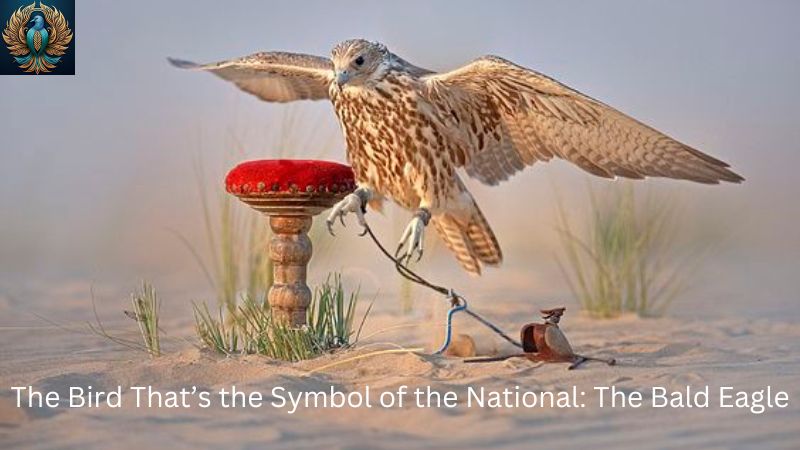Birds and Bird Behavior
The Bird That’s the Symbol of the National: The Bald Eagle 2024
The Bird That’s the Symbol of the National – When we think about national symbols, a few images come to mind: flags, anthems, and emblems that represent the identity, history, and values of a country. In the United States, one of the most iconic national symbols is the bald eagle (Haliaeetus leucocephalus). This majestic bird, with its striking white head and powerful presence, has come to embody the spirit of America—freedom, strength, and resilience.
But how did the bald eagle achieve such an exalted status, and what makes it so special? This article Bird Lovers Haven explores the fascinating story of the bald eagle, from its selection as a national symbol to its current status in the wild, and why it continues to be a powerful representation of the United States.
Table of contents
ToggleThe Bald Eagle: The Bird That’s the Symbol of the National
The bald eagle’s association with America dates back to the early days of the nation. In 1782, the bald eagle was officially chosen as the emblem of the United States, featured prominently on the Great Seal of the United States. This decision was made by the Continental Congress, who saw the bald eagle as a fitting symbol for the new nation they were forging. The bird’s characteristics—its keen eyesight, powerful flight, and solitary nature—were seen as reflections of the ideals of independence and strength.
Before its official adoption, there was some debate over which bird should represent the United States. Benjamin Franklin famously argued for the wild turkey, which he considered a more “respectable” bird. Franklin believed the turkey was a true native of America and possessed qualities that he admired. However, the bald eagle was ultimately chosen, largely due to its majestic appearance and widespread presence across the continent.
Physical Characteristics of the Bald Eagle
The bald eagle is an impressive bird of prey, known for its distinctive appearance and large size. Adult bald eagles have a wingspan of up to 7 feet (2.1 meters) and can weigh between 6.6 to 14 pounds (3 to 6.3 kilograms). Their most recognizable feature is the stark contrast between their white head and tail feathers and their dark brown body and wings. Despite its name, the bald eagle is not actually bald; the term “bald” comes from an old English word, “balde,” meaning white, referring to the bird’s white-feathered head.
Bald eagles have powerful beaks and talons, which they use to catch and consume their prey. Their diet primarily consists of fish, which they snatch from the water with their sharp talons. However, they are opportunistic feeders and will also eat small mammals, birds, and carrion when available.
One of the most remarkable features of the bald eagle is its eyesight. Eagles have vision that is four to five times better than that of a human, allowing them to spot prey from great distances. This incredible vision is one reason why the eagle has long been a symbol of keen insight and vigilance.
The Bald Eagle’s Habitat and Range
The bald eagle is native to North America, with a range that extends from Alaska and Canada down through the contiguous United States and into northern Mexico. They are typically found near large bodies of open water, such as lakes, rivers, and coastal regions, where they have ample access to fish, their primary food source. The presence of tall, sturdy trees is also important for nesting, as bald eagles build large nests—known as eyries—high above the ground.
These nests are among the largest in the bird world, often measuring up to 8 feet wide and weighing as much as a ton. Eagles typically use the same nest year after year, adding new material each breeding season, which contributes to the nest’s massive size.
Bald eagles are highly territorial during the breeding season and will defend their nesting area from other eagles and potential predators. Outside of the breeding season, however, they are more social and can often be seen congregating in groups, especially near plentiful food sources.
The Bald Eagle’s Role in Native American Culture

Long before the bald eagle became a national symbol for the United States, it held significant meaning for many Native American tribes. The bald eagle, along with the golden eagle, is revered in Native American culture as a symbol of spiritual power, courage, and wisdom. Eagle feathers, in particular, are considered sacred and are used in various religious and cultural ceremonies.
To many Native American tribes, the eagle is a messenger from the gods, carrying prayers to the heavens and bringing back messages from the spirit world. The bird’s ability to soar high above the earth, closer to the sky than any other creature, is seen as a powerful connection to the divine.
In recognition of the eagle’s importance, many tribes have strict traditions surrounding the collection and use of eagle feathers. The Bald and Golden Eagle Protection Act, passed in 1940, prohibits the killing, selling, or possessing of bald and golden eagles, but provides an exception for Native Americans who need feathers for religious or cultural purposes. These feathers are distributed through a regulated process to ensure the species’ protection while honoring the traditions of Native American tribes.
The Bald Eagle’s Conservation Journey
While the bald eagle is now a thriving species, its population was once in serious decline. By the mid-20th century, the bald eagle faced the threat of extinction due to habitat loss, hunting, and the widespread use of the pesticide DDT. DDT, in particular, had a devastating impact on eagle populations by causing the thinning of eggshells, leading to reproductive failures.
In response to the alarming decline, the bald eagle was listed as an endangered species under the Endangered Species Act of 1973. This listing, combined with a ban on DDT in 1972 and aggressive conservation efforts, helped the bald eagle population to recover. Habitat protection, legal protection from hunting, and captive breeding programs were all crucial in bringing the bald eagle back from the brink of extinction.
By 2007, the bald eagle population had rebounded to the point where it was removed from the Endangered Species list. Today, the bald eagle is considered a conservation success story, with an estimated 316,700 individuals in the wild as of 2020. The bird remains protected under the Bald and Golden Eagle Protection Act, ensuring that its population continues to thrive.
The Bald Eagle’s Symbolism in Modern America
In contemporary America, the bald eagle continues to be a powerful symbol of national pride and identity. It is prominently featured on the Great Seal of the United States, currency, military insignia, and various government logos. The eagle’s image is often used in patriotic displays, political campaigns, and national monuments, reinforcing its status as a representation of American ideals.
The bald eagle’s symbolism extends beyond its official uses; it is also a popular figure in American culture, representing freedom, resilience, and the enduring spirit of the nation. Its recovery from near extinction is often cited as a metaphor for the resilience of the American people, capable of overcoming challenges and emerging stronger.
In addition to its symbolic importance, the bald eagle also serves as a reminder of the importance of conservation efforts. Its successful recovery highlights the impact of coordinated efforts to protect endangered species and the importance of preserving natural habitats for future generations.
Bald Eagles in Popular Culture and Art
The bald eagle’s image has been immortalized in various forms of art and popular culture, further cementing its status as a national icon. From paintings and sculptures to literature and film, the bald eagle is often depicted as a symbol of strength, freedom, and patriotism.
In art, the bald eagle is frequently portrayed in majestic poses, soaring through the sky or perched proudly with its sharp eyes scanning the horizon. These depictions often emphasize the bird’s regal appearance and powerful presence, capturing the qualities that have made it a symbol of the nation.
The bald eagle also appears in numerous films and television shows, often used to evoke a sense of American identity or to underscore themes of freedom and independence. Its image is synonymous with the concept of “the American dream” and is often invoked in contexts where the values of liberty and justice are celebrated.
Conclusion
The bald eagle’s journey from a revered bird in Native American culture to an endangered species, and finally to its status as a national symbol and conservation success story, is a remarkable one. This bird, with its striking appearance and powerful symbolism, has come to represent the very essence of the United States.
As a symbol, the bald eagle embodies the ideals of freedom, strength, and resilience—qualities that are deeply ingrained in the American identity. Its recovery from the brink of extinction serves as a testament to the effectiveness of conservation efforts and the importance of preserving our natural heritage.
Today, the bald eagle stands as a proud emblem of the nation, a reminder of the power of collective action, and a symbol of hope for the future. Whether seen soaring high above the landscape or depicted on the nation’s emblems, the bald eagle remains a powerful and enduring representation of the United States.





